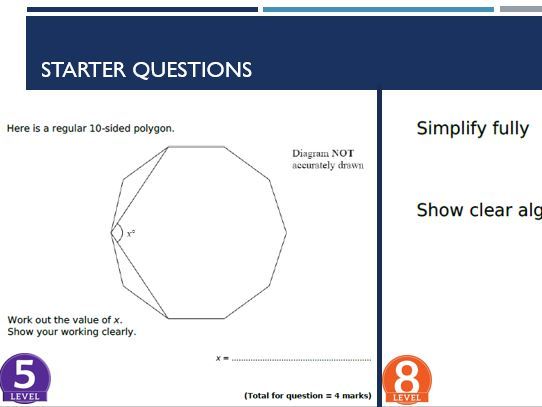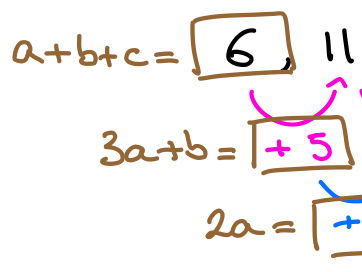
42Uploads
15k+Views
7k+Downloads
All resources

Embedded Linear Simultaneous Equations
30+ linear simultaneous equation problems. The PowerPoint starts with a quick recap on how to solve using either substitution or elimination. Most problems require students to transfer skills from other contexts in order to solve the problem. Problems include, linear and quadratic sequence, equations of quadratic graphs, angle properties, equation of a line, area and perimeter, index rules, HCF & LCM, pressure and density, etc.

GCSE 9-1 Maths Starters (Target Grades 4-6)
20 Maths starters for targeting grades 4 - 6 on a Higher Paper. Also works well if teaching a boarder line class with a few students writing the Foundation Exam. Most starters have complete solutions. Questions are taken from various Edexcel Exam papers and contains questions from levels 4 - 9. Certain higher level questions are given for students to transfer their skills and obtain some of the marks.

GCSE 9-1 Maths Higher Level Starters (Target 8-9)
The following starter questions are for students targeting grades 7-9. Questions are taken from various exam boards and include solutions. Encourages students to think and apply their skills in different contexts. Entire PowerPoint includes over 50 questions in the following categories:
Coordinate Geometry - Circles
Geometric Problems and Proof
Algebraic Proof
Trigonometry
Inequalities
Functions
Coordinate Geometry – Lines & Curves
Sequences
Algebraic Problems – including ratio
Indices and Surds
Statistics
Extra

Common Factoring - Introductory Lesson
The Following lesson introduces the concept of common factoring through numerical calculators where students find quicker and easier ways to mental calculator sums through the use of common factoring. It then moves on to algebraic factoring with visual displays (algebraic tiles) and finishes with piecewise factoring. The idea is to move from piecewise factoring onto expanding double brackets.

GCSE 9-1 Maths Must Know Topics
Lesson 1: Quadratic Sequences
Lesson 2: Completing the Square
Lesson 3: Iteration
Lesson 4: Composite Functions
Each lesson includes worked examples and practice questions. Alternative methods are shown for completing the square. Iteration lesson includes a video and graphical representation of how iteration works to deepen student understanding.

IB Maths Applications and Interpretation SL: Chapter 5 - Modelling Constant Rates of Change
The following PowerPoint covers the following topics following the Oxford textbook. Topics covered include:
Functions
* reation
* domain and range
* mapping diagrams
* number system
* set notation
* interval notation
* what is a function
* vertical line test
* function notation (numerical, graphical, and algebraic)
* finding equation of functions from a mapping diagram
Linear Models
* recap equation of a line
* rates of change
* simultaneous equations
* direct proportion
* inverse functions
* domain and range
* horizontal line test (one-to-one)
* finding inverse functions
Arithmetic Sequences
Arithmetic Series
* sigma notation
Simple interest
Modelling
Through the PowerPoint there are links to youtube videos, GeoGebra and Desmos interactives, and Desmos Classroom activities. The PowerPoint has worked examples, and student exercises. I have also put in past paper exam questions for each topic.

IB Maths Analysis and Approaches SL: Quadratic Inequalities
I used this lesson before going into the quadratic formula and the discriminant.

IB Maths Applications and Interpretation SL: Chapter 3 - Representing and Describing Data
This PowerPoint follows the Oxford textbook.
The following content is covered throughout the PowerPoint. I have also added a few extra concepts which can be used in students Internal Assessments (IA). For example, I spend a little time looking at the skewness formula, different ways of calculating outliers, 1.5 x IQR or 2 X SD, skewness in box plots, etc.
Univariate data
* qualitative vs quantitative
* continuous vs discrete
* which representations are used for specific types of data
* primary and secondary data
* choosing a good sample
* sampling bias
* reliability vs validity
* skewness
Questionnaires
* biased questions
Measures of central tendency
* mean, meadian, mode
* outliers
* un-grouped and grouped
* how to use the GDC
* combined mean
Measures of dispersion
* range, quartiles, IQR, standard deviation
* normal distribution curve
* skewness
* different formulas for sample and population for SD
* how to use the GDC
* effects on mean and SD
Sampling techniques
Presentation of data
Bivariate data
* scatter graphs
* correlation
* introduction into the line of best fit (leading into chapter 6)
Throughout the PowerPoint there are worked examples and student exercises. There are also multiple links to various classroom and interactive activities using GeoGebra and Desmos Classrooms. As well, I have included links to certain Youtube videos to help with using the GDC.

IB Maths Applications and Interpretation SL: Chapter 6 - Modelling Relationships
The following PowerPoint covers Chapter 6 from the Oxford textbook. Modelling Relationships: Linear Correlation and Bivariate Data. The Lesson contains various interactive activities such as Desmos Classroom for review exercises, Geogebra and Phet Simulations for showing line of best fit, least-squares, etc. There are also video links on how to used the GDC to find correlation and linear regression. The PowerPoint covers the following content below.
correlation review (from chapter 3)
finding correlation coefficient (PMCC)
discussion about covariance
interpreting PMCC
correlation and causation
coefficient of determination
line of best fit
interpolation and extrapolation
reliability
linear regression
residuals
piecewise functions
* step functions
All my PowerPoints have worked examples and exercises for students to complete. I have also added past paper questions in each section to get students accustom to the type and style of questions they will see on their exam. This PowerPower in particular comes with a Microsoft Teams quiz on Correlation and Linear Regression.

IB Maths Applications and Interpretation SL: Chapter 4 - Dividing Up Space
The PowerPoint follows chapter 4 from the Oxford textbook. There are worked examples, student exercises and past paper exam questions for each section. I have also embedded links to various Youtube, GeoGebra and Desmos activities and visuals to help improve student understanding. The PowerPoint contains the following content:
recap piecewise functions
the number plane
distance between 2 points (2D & 3D)
midpoint (2D & 3D)
classifying triangles given coordinates
coordinate geometry in 3D space
gradients
different forms of an equation of a line
points of intersection
parallel and perpendicular lines
collinear points
perpendicular bisectors
shortest distance to a line

IB Maths Applications and Interpretation SL: Chapter 2 - Representing Space
The PowerPoint covers the complete content of Chapter 2 of the Oxford textbook. I have also added a few extension topics which build upon what students are learning and will be useful further in the course. Topics cover in the PowerPoint include:
The sine law
* the ambiguous case
The cosine law
Area of non-right angle triangles
Algebraic triangle problems
3D Problems involving non-right angle triangles
Area of sectors
Area of Segments
3D shapes
* surface area
* volume
* writing expressions
* algebraic problems
* capacity
There are also Past Paper questions embedded into the lesson along with various GeoGebra and Desmos interactive activities.

IB Maths Applications and Interpretation SL: Financial Mathematics
The following contains 4 PowerPoints covering the following topics:
Simple Interest
Compound Interest
Inflation
Depreciation
Loans
Annuities
Amortization
Each PowerPoint contains worked examples, student exercises and Past Exam questions. There are also links throughout to various YouTube explanations (eg. difference between simple interest and compound interest, what is amortization?, etc.), How to use the GDC examples, Desmos, and Geogebra interactives.

IB Maths AI: Voronoi Diagrams
This complete lessons contains Desmos and GeoGebra interactives to demonstrate how to create voronoi diagrams, as well as examples. The lesson starts off with a review on finding equations of perpendicular bisectors then moves into a explorative task about voronoi diagrams. The lessons covers the following topics:
equation of a perpendicular bisector
how to construct a perpendicular bisector
key terminology used when constructing voronoi diagrams
how to construct a voronoi diagram with multiple sites
finidng centre of a circle using perpendicular bisectors of cords
finding locations of missing sites
nearest neighbour
adding new sites to a voronoi diagram
toxic waste dump problems (largest circle)
At the end this is a multiple choice quiz. There are also embedded link to Desmos Classroom activities. As well, throughout the PowerPoint there are worked examples and exercises and past paper exam questions for students to complete.

IB Maths: Applications and Interpretation SL - Exponential and Logarithmic Functions
Complete PowerPoints for Chapter 10 - Modelling Rates of Change: Exponential and Logarithmic Functions, for the Oxford textbook. The PowerPowers can be used with other textbooks. PowerPoints are built around students learning the the following topics online, but can also be used to deliver in-class. PowerPoints have embedded links to video examples, Desmos activities, GeoGebra, and Casio GDC videos. The following is the topics that the 8 PowerPoints cover.
Geometric Sequences
Geometric Series
Compound Interest
Annuities
Amortization
Exponential Functions
Exponential Models
Exponential & Logarithmic Equations
There are also Past Paper questions in each section of the unit.

Bungee Barbie - Scatter Graphs and Line of Best Fit
This activity requires students to gather data to construct a scatter graph. After students have constructed the scatter graph they then have to find the equation of the line of best fit and use that to make a prediction of how many bands are needed for the bungee jump. Calculations will be off which lead to the discussion of interpolation and extrapolation and why maths in the real world does not always match up with theoretical predictions.
The PowerPoint comes with a worksheet that students will use to fill in. I have also attached an egg version. The activity will take at least 2 days. One day to gather their information and the second to test their predictions.

Higher GCSE Maths Starters (Target 5 - 9)
Th bundle contains 32 days worth of starters. Each stater comprises of 2 questions. One being of level 4 or 5 and the other of level 7 to 9. The idea is that students will practice both questions from the beginning and ending of the exam. I find higher level students tend to make mistakes early of in the exam and this allows them to practice these types of questions in class. Thus helping to improve results.

Quadratic Sequences - Complete Lesson
The lesson looks at the differences between a linear and quadratic sequences graphically and focusing on finite differences, thus leading to the nth term. The lesson identifies two methods for finding the nth term of a quadratic sequence with multiple questions in different contexts. Questions also have students transferring skills from other topics such as area, solving equations, simultaneous equations, etc.
This lesson can also be used with AQA Further Maths students as the PowerPoint ens with limiting value of a sequence.

Time Series Assignment
Here is a short independent task looking at time series of population over time. It also creates discussion for curves of best fit.

IB Maths Applications and Interpretation SL: Statistics - Data Collection & One -Variable Analysis
The following four presentation was created for the Applications and Interpretations SL course following the order of teaching for the Kognity textbook but can also be used with the Pearson or Oxford textbook.
The following PowerPoints go through the following:
Introduction to Statistics
-types of data - qualitative and quantitative
-types of data - discrete and continuous
-collecting data - primary and secondary
-population, sample, census
-choosing a good sample - sampling frame, sampling unit, etc.
-sampling bias
-reliability vs validity
-questionnaires
-what makes a good survey - eg. biased questions, vague questions, leading questions, etc.
Sampling Techniques
-types of sampling - simple random, stratified, systematic, voluntary, convenience, and quota
-pros and cons for each
Measures of Central Tendency **
-mean, median and mode
-skewed data
-difference between population mean and sample mean
-grouped and un-grouped data
-how to use GDC
-outliers
-effect of outliers on mean and median
-combined mean
Measures of Spread
-Range, IQR, variance, and standard deviation
-lower quartile and upper quartile
-how to use GDC
-difference between population and sample standard deviation
-effects of SD on normal distribution curve
-normal distribution curve
-transformation of data
-outliers using mean and SD
Throughout the PowerPoint there are worked examples along with exercises for students. I have also included a few Desmos and Geogebra interactive links to help students get a better understanding of the concepts through visuals. At the end of each section I have included IB exam questions so students get get practice to the types and style of questioning they should expect to see when they write their exams. I also have included a few thinking questions, a few taken from A Level maths exams. There are also links to YouTube videos to help students understanding with certain content.

IB Maths Applications and Interpretation SL: Chapter 8 - Spearman's, Hypothesis Testing, Chi-Squared
This unit contains 5 Powerpoints:
Spearman’s rank
hypothesis testing - chi-squared test of independence
goodness of fit test
goodness of fit - normal and binomial distributions
t-test
Through the PowerPoint there are links to Youtube videos, GeoGebra and Desmos interactive. The PowerPoint has worked examples, and student exercises. I have also put in past paper exam questions for each topic.
I have also included an overall Statistics Test (2 parts short and long questions) and Chi-Squared test of Independence assignment, both with markschemes. As well as a review PowerPoint on the test of Independence. We sent a lot of time on this chapter as the idea was many students would use this for their IA’s, which they did.




















